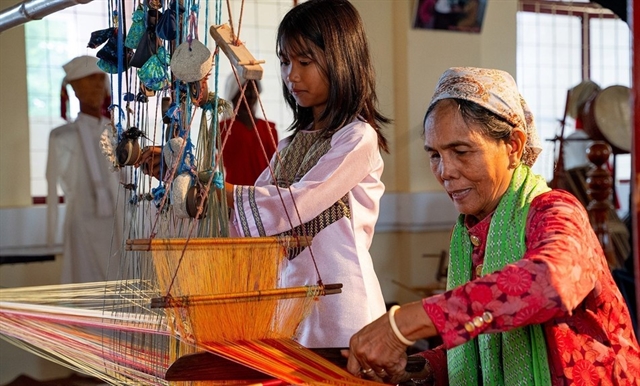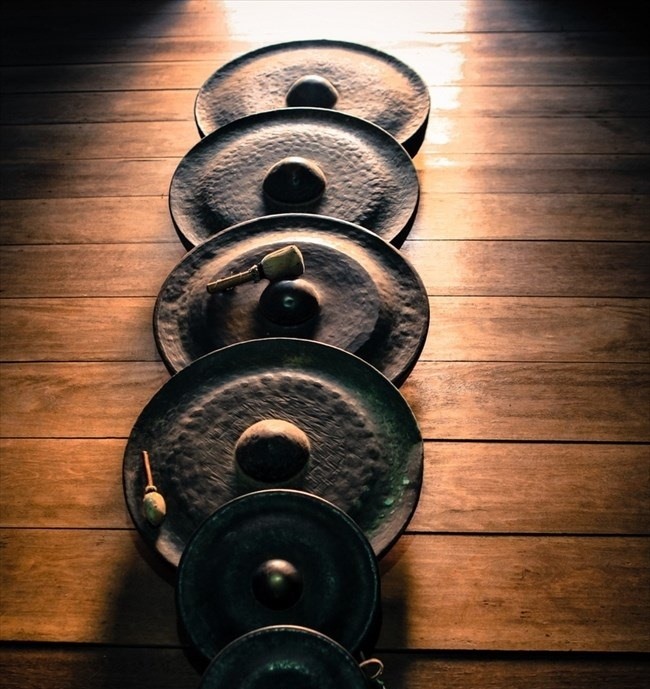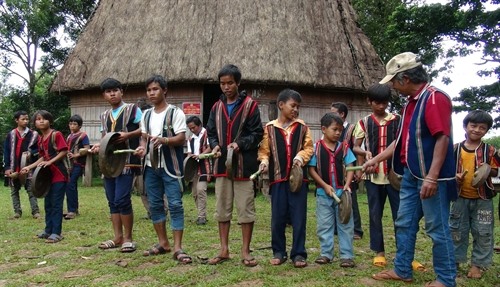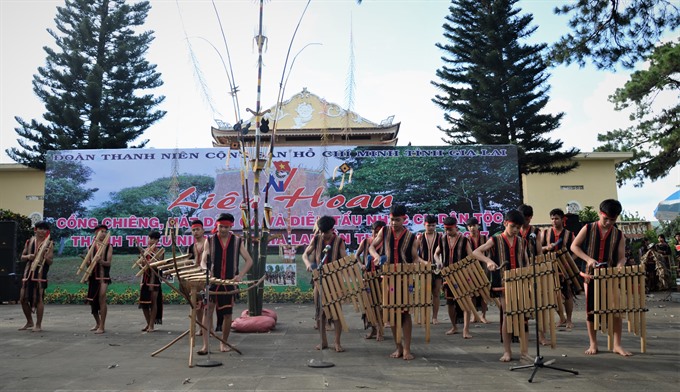 Features
Features

Realising that the key force in preserving this national heritage are young people, Gia Lai cultural authority has attached great importance to engaging children and teenagers in gong sessions, as well as traditional folk singing and dancing classes.
 |
| Pricey piece: The gong indicates the wealth of a family. There was a time when the cost of a gong was equivalent to that of two elephants or 20 buffaloes. — Photo vietnam.vnanet.vn |
Hồng Vân & Dư Toán
The gong, a musical instrument native to the Central Highlands, is popular in the five provinces of Kon Tum, Gia Lai, Đắk Lắk, Đắk Nông, and Lâm Đồng.
Realising that the key force in preserving this national heritage are young people, Gia Lai cultural authority has attached great importance to engaging children and teenagers in gong sessions, as well as traditional folk singing and dancing classes.
Theo, a 12-year-old from Đak Đoa District, said she learnt about the traditional art forms of her ethnic group when she was little. She joined a xoang dance class and was selected to perform in the Gong, Folk Singing and Folk Music Instrument Festival for young people in 2017.
“Initially, I joined a traditional dance class conducted by veteran artistes of my village, and then learned to sing. I feel it is the responsibility of the youngsters to preserve the traditional art and culture of our ethnic group,” Theo said.
 |
| Next generation: Realising the key force to preserving traditional art forms are young people, Gia Lai province has attached great importance to engaging children and teenagers in gong sessions, as well as traditional folk singing and dancing classes. — VNA/VNS Photo Hoài Nam |
The Culture and Information Department of Đak Đoa District has been offering free classes to teach the gong and the traditional xoang dance to students from 8 to 18 years since 2012.
Each xoang class attracts up to 50 students, while the gong class has 25 male students, as only the men play the gong in Đak Đoa, where most of the population is of the ethnic Ba Na and Jrai origin.
Đinh Thị Lan from the Culture and Information Department said, “Teachers who conduct these classes are artistes from the district itself, as the gong culture varies in various districts. We have invited the most experienced and dedicated artistes from each gong troupe in the villages to teach the younger generation about the instrument.”
“The annual culture and sport contest is also an opportunity for the locals to compete in traditional folk games and perform the gong, as well as learn and acquire skills from each other,” Lan told Việt Nam News.
Kbang District, where nearly half of the population is Ba Na, has more than 100 gong troupes, of which, seven are made up of teenagers.
Gong has been recognised as the Masterpiece of the Oral and Intangible Heritage of Humanity by UNESCO in 2005. It is an indispensable element in almost every ritual and cultural event of the community.
 |
| Playing together: The 2017 Gong, Folk Singing and Folk Music Instrument Festival for the youth attracted more than 500 artistes, most of whom are teenagers from 16 art troupes across the province. — VNA/VNS Photo Dư Toán |
Gong is also closely linked to the daily life of the ethnic people. It is believed that it can produce a language that can help connect humans to the supernatural world. People also believe a deity resides in each gong, who becomes more powerful as the gong becomes older.
Gong also indicates the wealth of a family.
“A family may own a fancy house and a car, but if it does not have a gong, it is not considered wealthy,” said Y Thim, an Ê Đê native, who owns 20 such gongs. There was a time when the cost of a gong was equivalent to that of two elephants or 20 buffaloes.
Gongs can be used separately or in a set of two to up to 20 units. With more than 100 villages, there are some 130 sets of gongs preserved by the locals in Đak Đoa. Gia Lai has a total of some 6,000 gongs.
“In the olden days, residents would exchange some buffaloes for a gong; therefore, it is hard to identify the age of the gongs, but some have been preserved for at least four generations,” said Lan.
Besides the gong classes, the villages, districts and provinces also hold annual or biannual festivals and cultural events featuring the gong, and folk singing and folk music instrument performances for young people.
The 2017 Gong, Folk Singing and Folk Music Instrument Festival for the youth, which is held every two years, attracted more than 500 artistes, most of whom are teenagers from 16 art troupes across the province. Each troupe contributed with three types of performances: gong, folk dance and folk music instrument performances. The youngest member was only seven and the oldest was 61.
The head of the organising board of the festival said, “The festival aims to protect and continue the distinctive cultural tradition of playing the gong, thus contributing to the efforts to preserve the cultural space of the gong. We hope the event also helps ignite a love for the ethnic heritage and encourage the establishment of a teenage art troupe.”
Đinh Jram, a 61-year-old artist from Kbang District, who performed in the festival in 2017, said, “As long as I am healthy, I will continue to dance, sing, play the gong and pass down the knowledge and skills among the younger generation.”
The people of Central Highlands believe that every thing has a soul, and only the sound of the gong can connect the various souls; therefore, the gong is played on special occasions, such as to celebrate a new crop, buffalo sacrifice, or during a ceremony to wish the newborn health and good luck, as well as during elephant races.
A festival in the Central Highlands conjures up images of the locals in their traditional costume, holding their hands and dancing around the camp fire, as the sound of the gongs echo in the deep forest during a tranquil night. VNS



.jpg)
